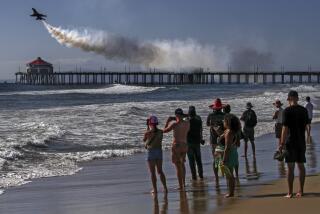Hollywood sign access remains a battle between competing interests

Way back in March, the Beachwood Canyon trail that leads to the Hollywood sign was temporarily closed so the city could install a new security gate.
That was supposed to take five weeks, but in Los Angeles, some public projects tend to drag on a bit.
Today, a mere nine months later, the gate has finally been completed. But there’s still a barricade at the entrance to the trail, and no firm date for when it will be accessible.
Hikers are not happy about this, and neither are tourists who flock from near and far to the Hollyridge trail head as if on a religious pilgrimage, determined to get as close as possible to the giant Scrabble letters hanging off a cliff.
“We came all the way from New York,” an angry tourist carped one day in September, when I watched a cavalcade of cars snake up Beachwood Drive to a sawhorse barricade.
She and others were stopped by a security guard who delivered the bad news with practiced perfunctoriness. He dutifully handed visitors directions to the Griffith Observatory and told them the view is good from there. The guard told me he was turning away more than a hundred visitors on weekdays and as many as 500 on weekends.
The woman from New York — true to her origins — wasn’t buying the guard’s explanation. She demanded to know why the whole trail had to be shut down just because a gate was being installed. It was a fair question, but the guard shrugged.
So what gives?
It’s all part of a long-running battle between competing interests. The public wants access to parkland and the best views of the sign, but many residents want a little peace and quiet rather than an endless stampede past their homes.
“It’s a regular goat rodeo up here on weekends,” one resident told The Times in March.
The goats have been able to find a route to the sign far more easily in recent years, thanks to Internet message boards and digital maps on phones, and that’s what has residents riled.
And hikers aren’t particularly happy, either. Alissa Walker has railed against the barricaded trail (which she told me she doesn’t let stop her) on Gizmodo.com and on her own website, awalkerinla.com, writing that homeowners have mounted “a vicious campaign threatening visitors.” She said they illegally painted curbs red and posted no-trespassing signs.
Walker said the city lobbied digital map makers to direct visitors looking to get to the sign to start from the Griffith Observatory rather than the closer access point on Hollyridge trail. One homeowner told me it was residents, not the city, who ultimately negotiated the changes. Either way, Walker asks a fair question: Can anyone simply call Google and change directions to an address, she wondered?
No doubt, the traffic is a nightmare for residents. They have pleaded with the city for years to end their misery, and City Councilman Tom LaBonge helped work out a plan. The city would install a more secure gate to discourage late-night visits, and it would further limit traffic by turning nearby streets into a permitted parking district weekends and holidays. Until that happens, the barricade will remain.
So why has it taken so long?
“I’d like it to be open tomorrow,” said LaBonge, who hikes daily in Griffith Park and said he was disappointed that it has taken so long to get the project through the city’s transportation and recreation departments.
Was there an effort on the part of some people to stall as long as possible?
Not according to Fran Reichenbach, a member of the Beachwood Canyon Neighborhood Assn. The gate had to be custom-made, she said, “and then the design had to change midstream” because the owners of the private stable near the trail head wanted to be able to push a button to open the gate for customers.
OK, but nine months? For a gate across a narrow lane maybe 30 feet wide? They could have put a fence around the entire park in that time. And by the way, LaBonge estimated it has cost in the neighborhood of $60,000 for private security, and I’m still working on getting a final tab for the gate.
In fact, let’s start a pool. Email me your estimates on the cost of the gate ($10,000, $100,000, $200,000?) by Wednesday and I’ll buy a picnic lunch and hike the trail with the person who came closest.
You’d think the city could have installed all the parking restriction signs while the gate issues dragged on, but no. The signage is only about 80% done, says LaBonge. And when that’s finished, said Reichenbach, there’ll be a 30-day grace period before cars are ticketed and the gate is opened to hikers and tourists.
So there’s no telling when the trail will be open.
But wait a second.
Was it ever officially, legally closed?
Walker said she strolls right past the guard, who has a “City of Los Angeles” patch on his sleeve, but has no authority in her opinion to block access to a public trail. Like the woman from New York, Walker doesn’t understand why the trail had to be closed just because a new gate was being constructed.
“There’s nothing the guard can do to stop you,” said Walker, who has not endeared herself to neighborhood residents. “I just tell people to keep going.”
As LaBonge has learned, it’s impossible to please everybody. Some neighbors are mad at him because they don’t want anyone going up there, he said, and other neighbors mad at him because they can’t use the trail themselves. His proposal to run tourists up there by shuttle, so they don’t all drive up separately, has gotten a big thumbs down from the neighborhood.
One thing LaBonge, Walker and Reichenbach all agree on is that the goats will keep coming, no matter what. Reichenbach thinks the city should tap tourism revenue to pay for better management of the problem with rangers, parking enforcement and traffic control.
Walker said they could use “signage that tells people where to go, a dedicated parking area, a dedicated viewing area ... interpretive trail map and stuff like that. All the things you normally have at world-famous landmarks like this. It’s just ridiculous that they don’t have that.”
LaBonge likes the idea of developing other ways for people to see the sign without plowing through residential areas. He thinks it’s worth kicking around an idea, first introduced and dismissed years ago, to run a tram — like the one in Palm Springs — from the San Fernando Valley up to the sign. And he’s pitched the idea of a giant Ferris wheel on Hollywood Boulevard to offer terrific photo ops.
If left to him, he’d turn the public land on the ridge above Lake Hollywood, near the Ford Theater, into an observation area. Makes sense to me, but I’m sure someone would have a problem with that idea, too.
Maybe it’s time for a public forum on these ideas and others. If you’ve got thoughts on how to better utilize one of the city’s greatest emblems and attractions, without spoiling the park or ticking off too many neighbors, shoot me a line.
If I get enough good stuff, I’ll do a follow-up in less than nine months, guaranteed.
More to Read
Sign up for Essential California
The most important California stories and recommendations in your inbox every morning.
You may occasionally receive promotional content from the Los Angeles Times.











